|
|
| |
|
|
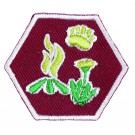 In nature, many species of plants whose fruits or parts of the plant itself, are edible.
Among the fungi (mushrooms), there are also some edible but these, I want to discourage.
For mushrooms you need to be highly trained, mushrooms can be toxic and are difficult to identify.
In nature, many species of plants whose fruits or parts of the plant itself, are edible.
Among the fungi (mushrooms), there are also some edible but these, I want to discourage.
For mushrooms you need to be highly trained, mushrooms can be toxic and are difficult to identify.
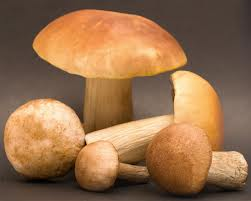 Some of the edible plants are treated here.
When in doubt you would be wise to test the plant prior to eating it. Use the following guidelines:
Some of the edible plants are treated here.
When in doubt you would be wise to test the plant prior to eating it. Use the following guidelines: |
| Edibility test - Guidelines |
|
| Do not eat plants that contain a milky sap. (The exception is the dandelion this is edible.) |
| Avoid plants that are red in color. |
| Do not eat old or withered leaves. |
| White and yellow berries are often poisonous. |
| Roots of plants should always be roasted for consumption. |
| The testing of a plant is not without danger, never go to work without proper background knowledge. |
| Testing |
|
| Step 1 |
crush a leaf of the plant that you want to test, dous it paste, stink or smells of almonds or peach, the plant most likely toxic. |
| Step 2 |
Rub the leaves on the inside of your arm and wait a few minutes, if it gets irritated, the plant is probably poisonous.
Otherwise, proceed to the next step. |
| Step 3 |
Place a small piece of the plant on your lips and wait 1 minute, if you get a burning or stinging sensation, the plant is
probably poisonous. Otherwise, proceed to the next step. |
| Step 4 |
Put a small piece on the tip of your tongue and wait one minute again, if you get a burning or stinging sensation, the plant is
probably poisonous. Otherwise, proceed to the next step. |
Step 5 |
Now put a little bit under your tongue and wait one minute again,if you get a burning or stinging sensation, the plant is
probably poisonous. At the onset of nausea as well. Otherwise, proceed to the next step. |
| Step 6 |
Now chew on a little bit, spit it out again and wait 1 minute. When you do not taste anything suspicious, you are not experiencing a
burning or stinging feeling, no nausea, diarrhea, stomach cramps or dizziness you might go to the next step. |
| Step 7 |
Eat a bit (teaspoon) and wait at least 5 hours. when there is no unpleasant reaction, you can assume that the plant is edible.
If you try a new plant eat it with known plants. If toxins are present in the plant, you get them dosed.
The palatability says nothing about the nutrients it gives to your diet. |
|
| |
|
Trees - Birch
|
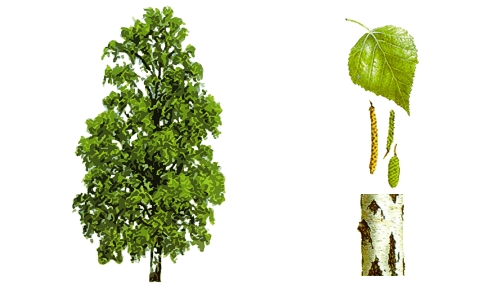 The raw Berk, is a deciduous small slender tree. It is easily recognized by its white bark. Birch are usually not that old.
In the far north against the tree line the birch can no longer sustain and crawls as a shrub on the ground. The birch is found in
northern and central Europe and grows preferably in wetlands. Although you can find it on all soil types.
The Birch provides drinkable juice, which consists mainly of water and sugars. The juice also contains tannin, vitamin C and essential oils.
Birch is nice to drink, a mature tree produces daily from 1 to 1.5 liter birchjuce. The best time to tap birch sap is in early spring, the buttons
raise on the branches of the birch. In the months March to June you can use the leaves as vegetables, nive in a salad or you can make tea out of them.
The raw Berk, is a deciduous small slender tree. It is easily recognized by its white bark. Birch are usually not that old.
In the far north against the tree line the birch can no longer sustain and crawls as a shrub on the ground. The birch is found in
northern and central Europe and grows preferably in wetlands. Although you can find it on all soil types.
The Birch provides drinkable juice, which consists mainly of water and sugars. The juice also contains tannin, vitamin C and essential oils.
Birch is nice to drink, a mature tree produces daily from 1 to 1.5 liter birchjuce. The best time to tap birch sap is in early spring, the buttons
raise on the branches of the birch. In the months March to June you can use the leaves as vegetables, nive in a salad or you can make tea out of them. |
| |
|
Trees - Oak
|
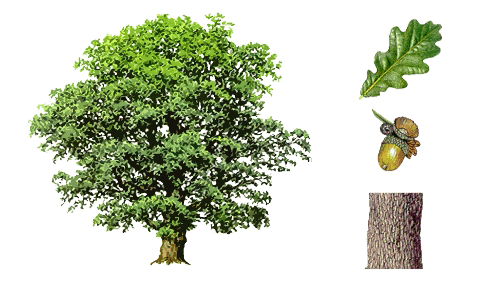 The oak is a deciduous tree up wich can grow up to 35 meters high. It has a broad domed crown. The oak has irregular lobed leaves that
are alternately attached to the branches. Found in deciduous forests throughout Europa. At the end of the summer you can roast, crush and store the acorns
of wich you can make coffee.
Roast until the see lightly browned. Grind them finely and rast them again.
The oak is a deciduous tree up wich can grow up to 35 meters high. It has a broad domed crown. The oak has irregular lobed leaves that
are alternately attached to the branches. Found in deciduous forests throughout Europa. At the end of the summer you can roast, crush and store the acorns
of wich you can make coffee.
Roast until the see lightly browned. Grind them finely and rast them again. |
| |
|
Trees - Walnut
|
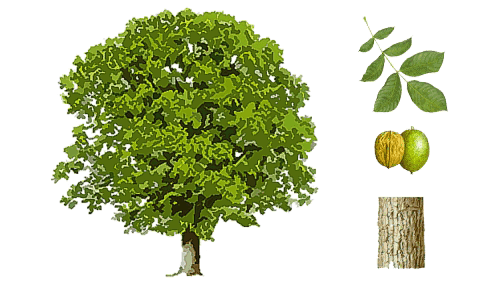 The walnut is a deciduous tree wich can reach to 30 meters high. The odd pinnate leaves may be 45cm long, usually leaves consist of 7 smaller leaves.
At the end of summer round green fruit come on the tree, this is the shell of the actual fruit.
Originally it comes from Asia and Southeast Europe, but now it can be found in almost entire Europe. The shell opens in fall wich releases the walnuts.
You can remove and peel the raw seeds or proces them in dishes.
The walnut is a deciduous tree wich can reach to 30 meters high. The odd pinnate leaves may be 45cm long, usually leaves consist of 7 smaller leaves.
At the end of summer round green fruit come on the tree, this is the shell of the actual fruit.
Originally it comes from Asia and Southeast Europe, but now it can be found in almost entire Europe. The shell opens in fall wich releases the walnuts.
You can remove and peel the raw seeds or proces them in dishes. |
| |
|
Trees - Sweet Chestnut
|
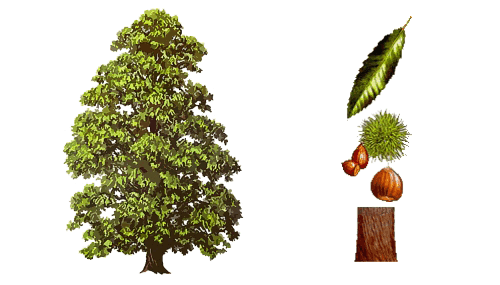 The chestnut is a deciduous tree that can reach up to 35 meters high. The leaves of the sweet chestnut are independently placed on the branches. While
the poisonous leaves of the horse chestnut from five fingers. It has it's origen in Southeast Europe, but is now almost like wandering around Europe.
The nuts can be peeled and eaten raw or they can be roasted in a fire before you eat them. The meal made out of sweet chestnuts can be used as flour.
The chestnut is a deciduous tree that can reach up to 35 meters high. The leaves of the sweet chestnut are independently placed on the branches. While
the poisonous leaves of the horse chestnut from five fingers. It has it's origen in Southeast Europe, but is now almost like wandering around Europe.
The nuts can be peeled and eaten raw or they can be roasted in a fire before you eat them. The meal made out of sweet chestnuts can be used as flour. |
| |
|
Trees - Fir
|
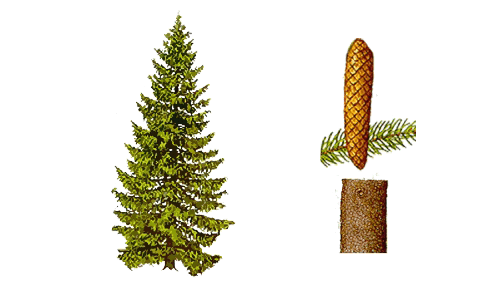 The fir is an evergreen coniferous tree that can reach up to 40 meters high. In virgin forests, you might find fir with a height of 60 meters.
The needles are placed separate on the branches, in contrast to the needles of a pinetrea where they are attached in pairs. Fir occur in the
northern hemisphere. The inner bark of the spruce is rich of Vitamin C, Remove the bark just above the roots of the tree. Then peel the outer bark
and boil the inner bark until it is soft. This you may eat. Out of the needles of the fir you can make tea, do so by adding fir needles to boiling water
and leave this to cook for about five minutes.
The fir is an evergreen coniferous tree that can reach up to 40 meters high. In virgin forests, you might find fir with a height of 60 meters.
The needles are placed separate on the branches, in contrast to the needles of a pinetrea where they are attached in pairs. Fir occur in the
northern hemisphere. The inner bark of the spruce is rich of Vitamin C, Remove the bark just above the roots of the tree. Then peel the outer bark
and boil the inner bark until it is soft. This you may eat. Out of the needles of the fir you can make tea, do so by adding fir needles to boiling water
and leave this to cook for about five minutes. |
| |
|
Trees - Scots pine
|
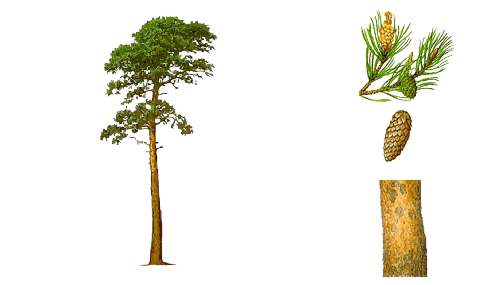 Scots pine is an evergreen conifer that can reach up to 25 to 35 meters high. The gray-green needles are placed in pairs and may reach reach for 8 cm.
The fruits are called pine cones, pine cones are green in the beginning and later they become brown. The pine cones can be about 8 cm long.
Heat mature pine cones so the seeds will be released. The inner bark and the pine needles are edible and high in vitamin C. From the needles of the pine
you can make tea. Do so by adding pine needles to boiling water and leave this to cook for about five minutes.
Scots pine is an evergreen conifer that can reach up to 25 to 35 meters high. The gray-green needles are placed in pairs and may reach reach for 8 cm.
The fruits are called pine cones, pine cones are green in the beginning and later they become brown. The pine cones can be about 8 cm long.
Heat mature pine cones so the seeds will be released. The inner bark and the pine needles are edible and high in vitamin C. From the needles of the pine
you can make tea. Do so by adding pine needles to boiling water and leave this to cook for about five minutes. |
| |
|
Trees - Hazel
|
 The hazel is a tree or shrub wich an reach up to 6 meters high. The branches reach up and the bark of the tree is smooth and brown of color.
The cut leaves are almost round and hairy. The fruits are called nuts, they grow in clusters of 3 to 4 nuts. Hazel can be found in hedgerows
and woods throughout Europe. You often find them in oak forrests. The ripe peeled hazelnuts can be roasted or eaten raw.
The hazel is a tree or shrub wich an reach up to 6 meters high. The branches reach up and the bark of the tree is smooth and brown of color.
The cut leaves are almost round and hairy. The fruits are called nuts, they grow in clusters of 3 to 4 nuts. Hazel can be found in hedgerows
and woods throughout Europe. You often find them in oak forrests. The ripe peeled hazelnuts can be roasted or eaten raw. |
| |
|
Trees - Rowan
|
 Rowan is a slender deciduous tree wich can reach up to 20 meters. The branches reach up and the tree has a smooth greyish bark around the
trunk. The leaves are pinnate and 10-25cm long. The leaves consist of 9-19 units smaller leaves.
In spring, small cream white flowers Origin. In summer, clusters of bright red berries emerge. The ripe berries can be cooked if they were frozen.
Then can make jam or jelly out of them. You can store berries in a dry place. The trea is found throughout Europe in dry forests, scrub and
rocky places. In the mountains you will often find them above 1000 meters.
Rowan is a slender deciduous tree wich can reach up to 20 meters. The branches reach up and the tree has a smooth greyish bark around the
trunk. The leaves are pinnate and 10-25cm long. The leaves consist of 9-19 units smaller leaves.
In spring, small cream white flowers Origin. In summer, clusters of bright red berries emerge. The ripe berries can be cooked if they were frozen.
Then can make jam or jelly out of them. You can store berries in a dry place. The trea is found throughout Europe in dry forests, scrub and
rocky places. In the mountains you will often find them above 1000 meters. |
| |
|
Trees - Juniper
|
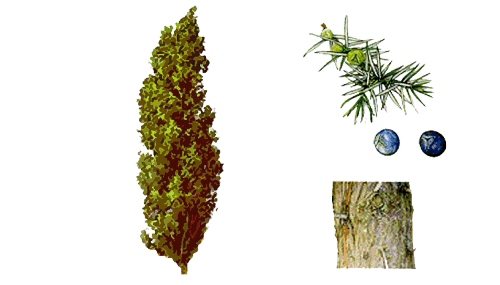 Juniper is a shrubby pine which grows erect and might reach up to 6 meters. It also grows creeping. It has a brown bark. The pointed green
needles grow in whorls of three and have a white band at the top. The cones look like round firm berries, first they are green but in the second year,
they are blue-black with a white haze.
The juniper is found throughout Europe. You can find them in the mountains, in peat bogs and suffered lower heathlands. De ripe blue-black b
erries can be roasted and used to ground meat as a spice. The wood of the juniper can be used for smoking ham and bacon.
Juniper is a shrubby pine which grows erect and might reach up to 6 meters. It also grows creeping. It has a brown bark. The pointed green
needles grow in whorls of three and have a white band at the top. The cones look like round firm berries, first they are green but in the second year,
they are blue-black with a white haze.
The juniper is found throughout Europe. You can find them in the mountains, in peat bogs and suffered lower heathlands. De ripe blue-black b
erries can be roasted and used to ground meat as a spice. The wood of the juniper can be used for smoking ham and bacon. |
| |
|
Trees - Elderberry
|
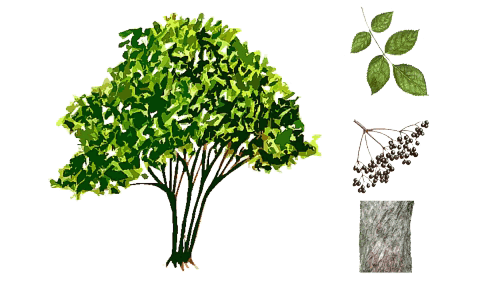 Elderberry is a large shrub that can reach up to 10 meters. Found in hedgerows, edges of moist woods and along roads and paths throughout Europe.
You can make jam out of it. The green parts are poisonous.
Elderberry is a large shrub that can reach up to 10 meters. Found in hedgerows, edges of moist woods and along roads and paths throughout Europe.
You can make jam out of it. The green parts are poisonous. |
| |
|
Bushes - blueberry
|
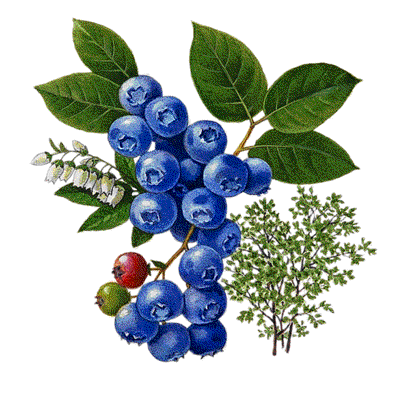 Blueberry is a deciduous shrub with a height of 30 to 60cm. Found on moors and bogs in a large extent throughout Europe.
The ripe fruits can be found in the months July to august. Blueberry are rich in vitamin C.
Blueberry is a deciduous shrub with a height of 30 to 60cm. Found on moors and bogs in a large extent throughout Europe.
The ripe fruits can be found in the months July to august. Blueberry are rich in vitamin C. |
| |
|
Bushes - Raspberry
|
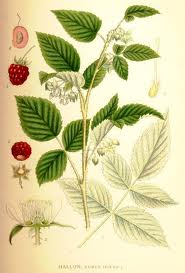 The raspberry is a thorny shrub creeping up to 150cm tall. The compound leaf has three to seven leaves
which turned green to whitish in color. Grows in open areas in forests scrub and occurs throughout Europe except
of Portugal. Gather the fruits from June to August and are edible. Collect the fresh young green
leaves from March to May, and let them dry to make a delicious tea.
The raspberry is a thorny shrub creeping up to 150cm tall. The compound leaf has three to seven leaves
which turned green to whitish in color. Grows in open areas in forests scrub and occurs throughout Europe except
of Portugal. Gather the fruits from June to August and are edible. Collect the fresh young green
leaves from March to May, and let them dry to make a delicious tea. |
| |
|
Bushes - blackberry
|
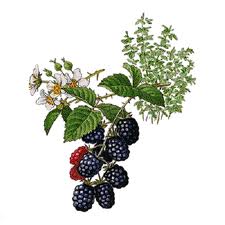 Blackberry is a thorny shrub wich grows in woods, hedges, open spaces and river banks. Mature fruits can be picked from August to
september. Blackberry go against diarrhea, kill bacteria and are widely used to treat disorders of the metabolism. Pick the leaves
before flowering time, and you can make tea out of them.
Blackberry is a thorny shrub wich grows in woods, hedges, open spaces and river banks. Mature fruits can be picked from August to
september. Blackberry go against diarrhea, kill bacteria and are widely used to treat disorders of the metabolism. Pick the leaves
before flowering time, and you can make tea out of them. |
| |
|
Aquatic plants - Water lilies
|
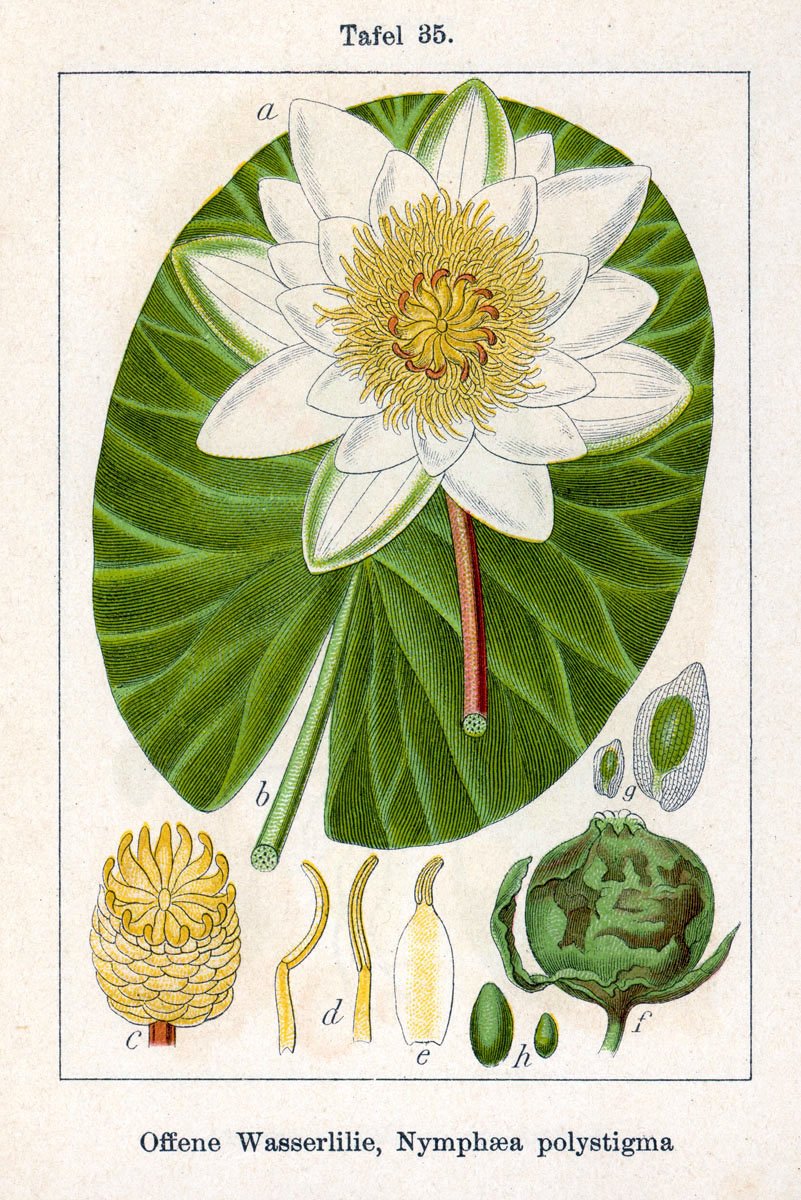 The water lily is an aquatic plant flowers and heart-shaped leaves float on the water. The roots wich reside in the ground keep the water lily in place.
There are about 60 species of water lilies, the lily grows in tropical and temperate areas. De flowers, seeds, stems and rhizomes are fresh foods.
To eat the rhizomes you need to first peel off the corky outer.
The water lily is an aquatic plant flowers and heart-shaped leaves float on the water. The roots wich reside in the ground keep the water lily in place.
There are about 60 species of water lilies, the lily grows in tropical and temperate areas. De flowers, seeds, stems and rhizomes are fresh foods.
To eat the rhizomes you need to first peel off the corky outer. |
| |
|
Aquatic plants - Cattail
|
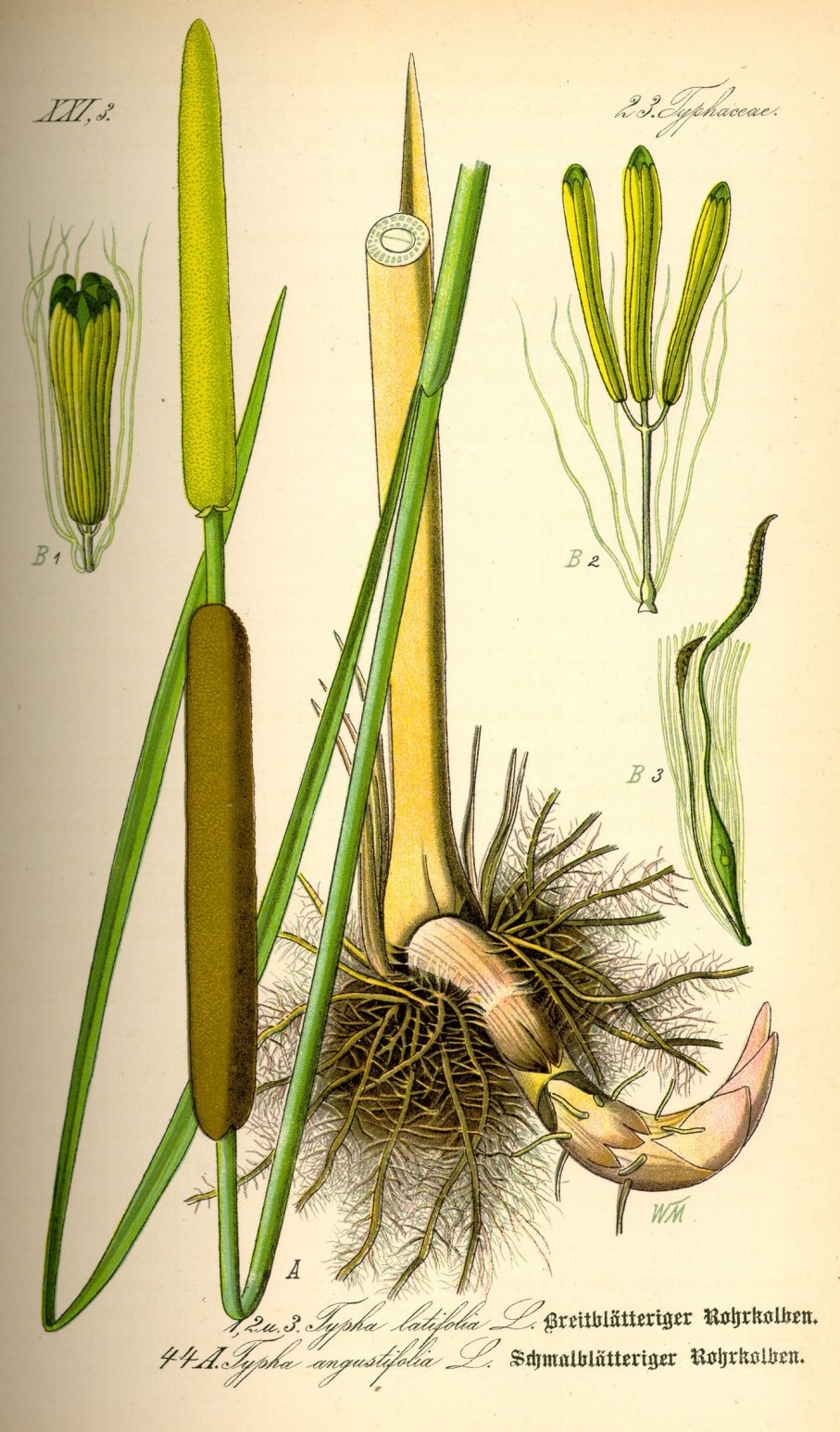 Cattail can grow to a height of 3 meters. Found in shallow water at the edges of lakes, ponds, along slow-moving streams and underground roots and rivers.
The roots you can cook in a fire. In the roots of the cattail is a lot of starch.
Cattail can grow to a height of 3 meters. Found in shallow water at the edges of lakes, ponds, along slow-moving streams and underground roots and rivers.
The roots you can cook in a fire. In the roots of the cattail is a lot of starch. |
| |
|
Aquatic plants - Reed
|
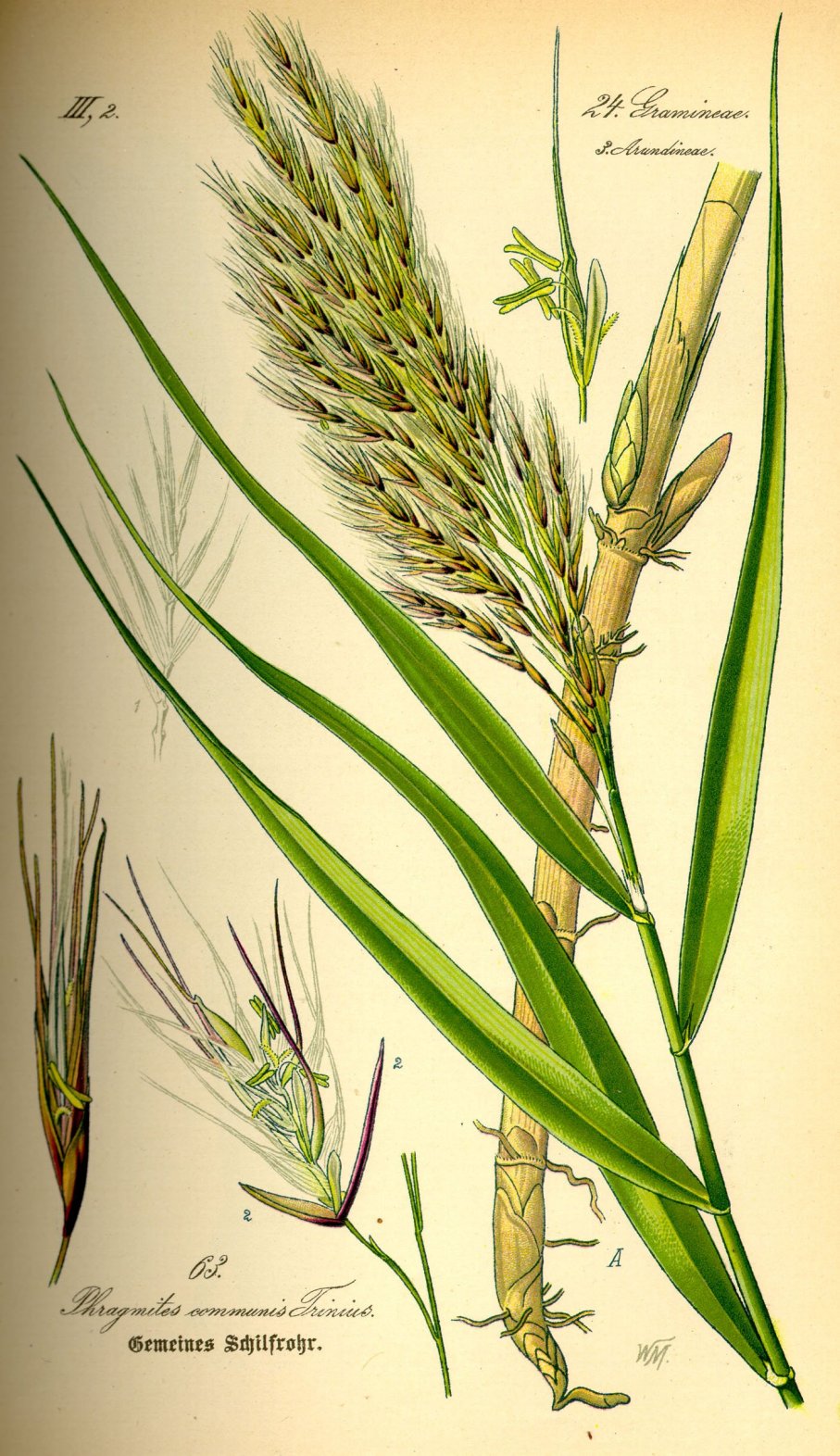 Reed is a plant belonging to the family of grasses. Cane is 1 to 3 meters high, from the upright stems grow 1 to 3 cm wide gray-green leaves.
Reed flowers from July to October with a purple or brownish plume that grows about 15-40 cm long. You might find Reed along the waterfront, in swamps,
in stagnant shallow water and sometimes in forrests. The roots are cooked edible. You can also punch a hole in the green stem and an edible sugary gum
will come out.
Reed is a plant belonging to the family of grasses. Cane is 1 to 3 meters high, from the upright stems grow 1 to 3 cm wide gray-green leaves.
Reed flowers from July to October with a purple or brownish plume that grows about 15-40 cm long. You might find Reed along the waterfront, in swamps,
in stagnant shallow water and sometimes in forrests. The roots are cooked edible. You can also punch a hole in the green stem and an edible sugary gum
will come out. |
| |
|
Other plants - Purple Dead Nettle
|
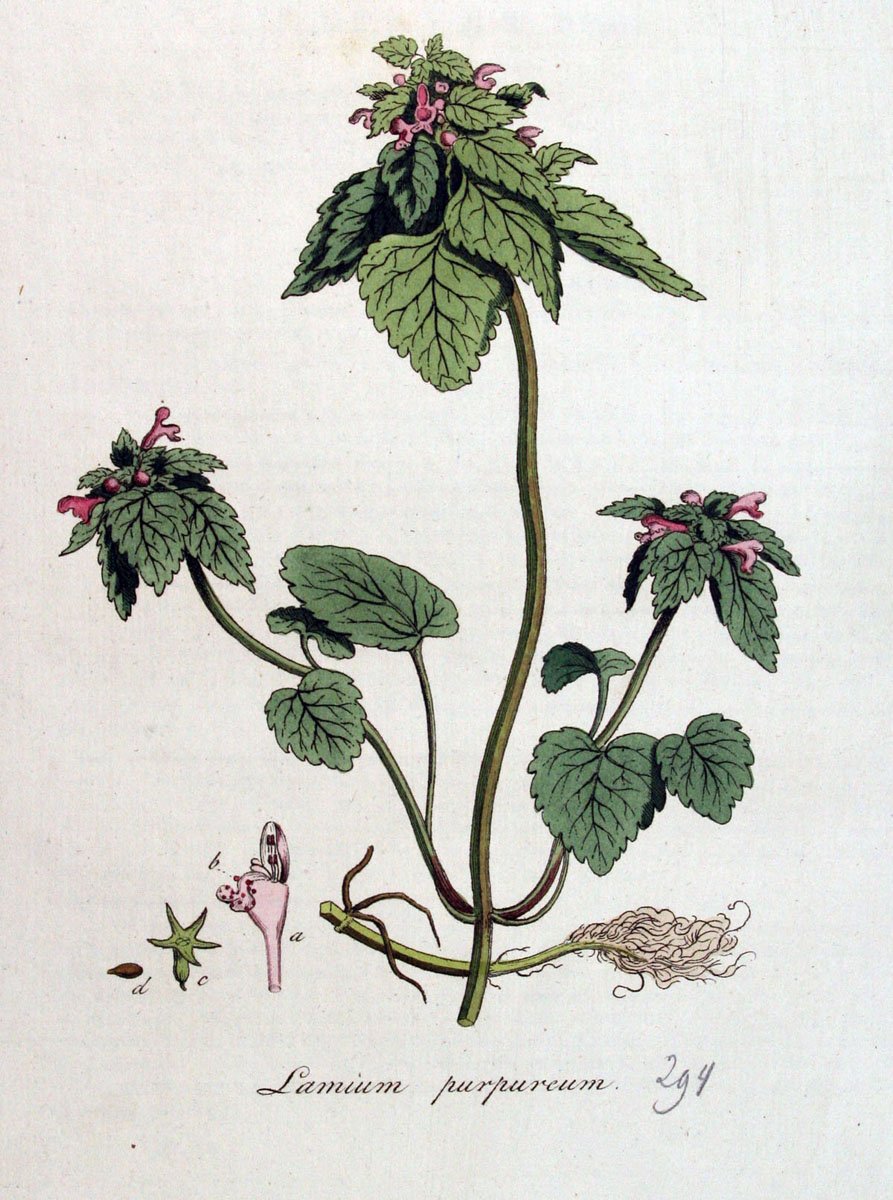 The Purple Dead Nettle is an annual plant that is 10 to 40cm high. The stem is is clearly square and the top purple
colored. The leaves are heart shaped and pointed toothed. (The leaves resemble those of a nettle). The flowers are
1 to 2 cm in size and are pink to purple. The flowering period is from February to September. In soft conditions, the purple dead-nettle
all year in bloom. De purple dead-nettle find in shady areas with moist soil such as roadsides and parks.
Pick the leaves, preferably when the flowers have hatched, eat the leaves raw or cook them for 10 minuten. The purple dead nettle causes
unlike the regular nettle no irritation on contact.
The Purple Dead Nettle is an annual plant that is 10 to 40cm high. The stem is is clearly square and the top purple
colored. The leaves are heart shaped and pointed toothed. (The leaves resemble those of a nettle). The flowers are
1 to 2 cm in size and are pink to purple. The flowering period is from February to September. In soft conditions, the purple dead-nettle
all year in bloom. De purple dead-nettle find in shady areas with moist soil such as roadsides and parks.
Pick the leaves, preferably when the flowers have hatched, eat the leaves raw or cook them for 10 minuten. The purple dead nettle causes
unlike the regular nettle no irritation on contact. |
| |
|
Other plants - White Dead Nettle
|
 The White dead-nettle, is a perennial plant to 60cm high. The square stem is hollow inside.
The leaves are serrated and the bottom leaves are heart shaped, upper leaves are oblong. The flowering period is from April
until August, then there are white flowers 2-4 cm shaped in a ring around the stem. You find the white nettle across
Europe, Asia and North America in woodland edges, ditches and roadsides. The white dead nettle causes as opposed to the regular nettle
no irritation on contact. The flower of the nettle is rich in nectar, and therefore popular with bees. Process the young
sprouts in salads and soups. You can also eat the white dead nettle as spinach. Tea made from the white nettle is recommended
to people with kidney problems. This dous not apply for the yellow Nettle.
The White dead-nettle, is a perennial plant to 60cm high. The square stem is hollow inside.
The leaves are serrated and the bottom leaves are heart shaped, upper leaves are oblong. The flowering period is from April
until August, then there are white flowers 2-4 cm shaped in a ring around the stem. You find the white nettle across
Europe, Asia and North America in woodland edges, ditches and roadsides. The white dead nettle causes as opposed to the regular nettle
no irritation on contact. The flower of the nettle is rich in nectar, and therefore popular with bees. Process the young
sprouts in salads and soups. You can also eat the white dead nettle as spinach. Tea made from the white nettle is recommended
to people with kidney problems. This dous not apply for the yellow Nettle. |
| |
|
Other plants - Mure
|
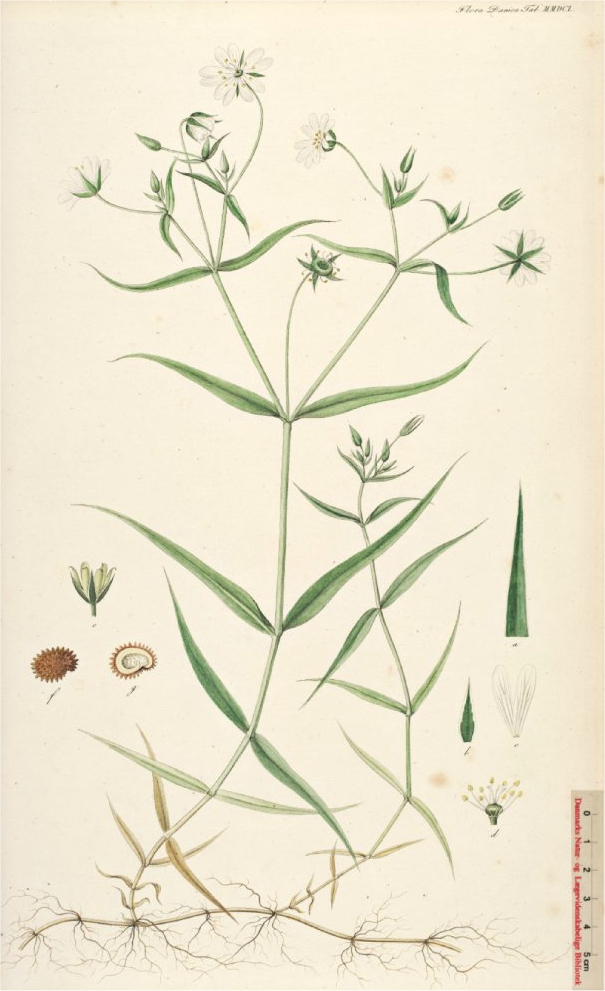 Mure, is an annual plant, with loose shoots of 5-40 cm. Recognizable by the egg-shaped leaves.
There is a straightedge few hairs along the stem. There are white flowers with five petals leading to the cut leaf base. These look
like miniature stars. The whole year can be found throughout Europe, in gardens, roadsides and arable land.
Young plants grow from autumn, these are an excellent green salad, rich in Vitamin C tastes slightly bitter.
Tastes well as cooked vegetables and mure tastes good in soup.
Mure, is an annual plant, with loose shoots of 5-40 cm. Recognizable by the egg-shaped leaves.
There is a straightedge few hairs along the stem. There are white flowers with five petals leading to the cut leaf base. These look
like miniature stars. The whole year can be found throughout Europe, in gardens, roadsides and arable land.
Young plants grow from autumn, these are an excellent green salad, rich in Vitamin C tastes slightly bitter.
Tastes well as cooked vegetables and mure tastes good in soup. |
| |
|
Other plants - Narrow Plantain
|
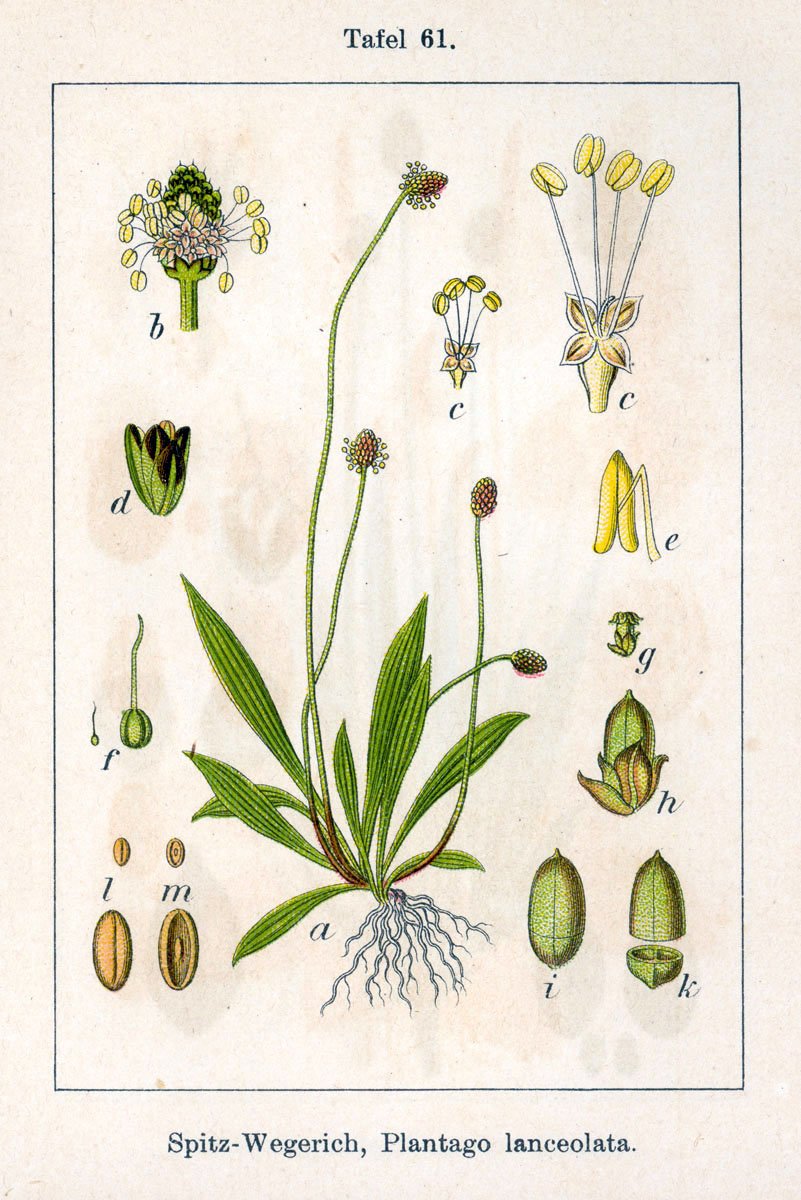 Narrow Plantain is a perennial with a short root and root collar. The leaves are straight, lanceolate and running with three to seven veins toward the center.
Found in fields and gardens, blooms from May to september. Gather young leaves in spring before flower stalks are developed. The plants recovers
quickly, so it is possible to pick them several times. Contains a lot of provitamin A and vitamin C, potassium, calcium and enzymes.
Narrow Plantain is a perennial with a short root and root collar. The leaves are straight, lanceolate and running with three to seven veins toward the center.
Found in fields and gardens, blooms from May to september. Gather young leaves in spring before flower stalks are developed. The plants recovers
quickly, so it is possible to pick them several times. Contains a lot of provitamin A and vitamin C, potassium, calcium and enzymes. |
| |
|
Other plants - Great plantain
|
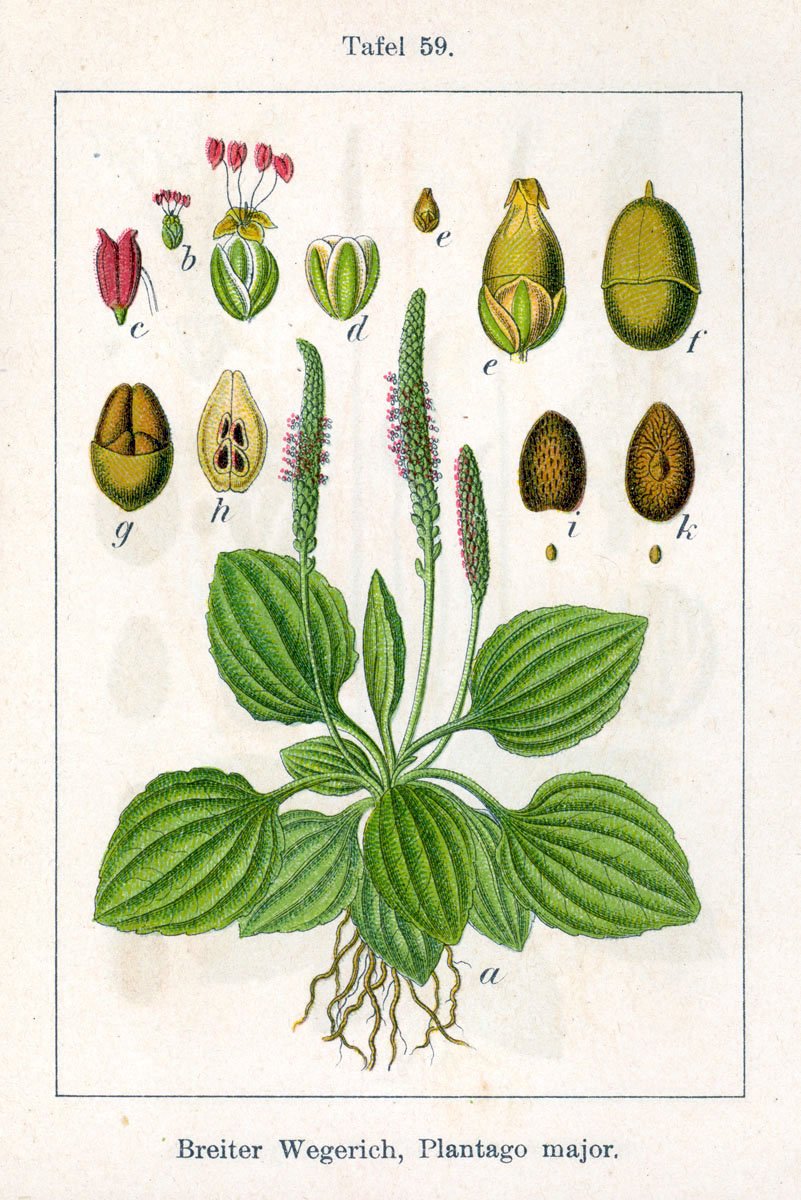 Great plantain is a perennial that 10 to 50 cm high. The leaves form a rosette of leaves lying flat. The large Plantain is easily identified by the
veins that run parallel to the leaves. The great plantain can be found along roads, in meadows and lawns. Plantain blooms from May to November,
and form a spike that circulates and can grow up to 15cm. The large plantain can be eaten raw when young. Boil the plantain as a vegetables or
add it into a soup. Rub the plantain leaves on skin to ease the pain off insect bites and nettle. Pulverizing the leaves have a healing effect on wounds.
Great plantain is a perennial that 10 to 50 cm high. The leaves form a rosette of leaves lying flat. The large Plantain is easily identified by the
veins that run parallel to the leaves. The great plantain can be found along roads, in meadows and lawns. Plantain blooms from May to November,
and form a spike that circulates and can grow up to 15cm. The large plantain can be eaten raw when young. Boil the plantain as a vegetables or
add it into a soup. Rub the plantain leaves on skin to ease the pain off insect bites and nettle. Pulverizing the leaves have a healing effect on wounds. |
| |
|
Other plants - Dandelion
|
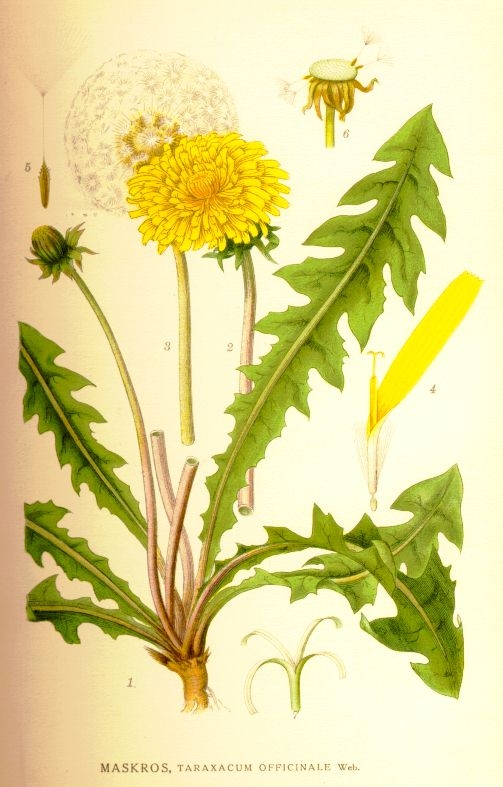 Dandelion is a common perennial. There are many species of dandelions wich are difficult to distinguish. The dandelion has milky sap.
The leaves are arranged in a rosette root, are oblong, lobed, toothed and fetherlike. Occurs in virtually all of Europe, flowering in May, summer
and autumn again. The leaves and roots are best harvested before the plant comes into bloom. The leaves contain vitamin C, provitamin A further they
contain potassium, sodium, manganese, copper and aluminum, the roots contain tannin and taraxine, the roots are suitable for diabetics.
Dandelion is a common perennial. There are many species of dandelions wich are difficult to distinguish. The dandelion has milky sap.
The leaves are arranged in a rosette root, are oblong, lobed, toothed and fetherlike. Occurs in virtually all of Europe, flowering in May, summer
and autumn again. The leaves and roots are best harvested before the plant comes into bloom. The leaves contain vitamin C, provitamin A further they
contain potassium, sodium, manganese, copper and aluminum, the roots contain tannin and taraxine, the roots are suitable for diabetics. |
| |
|
Other plants - Daisy
|
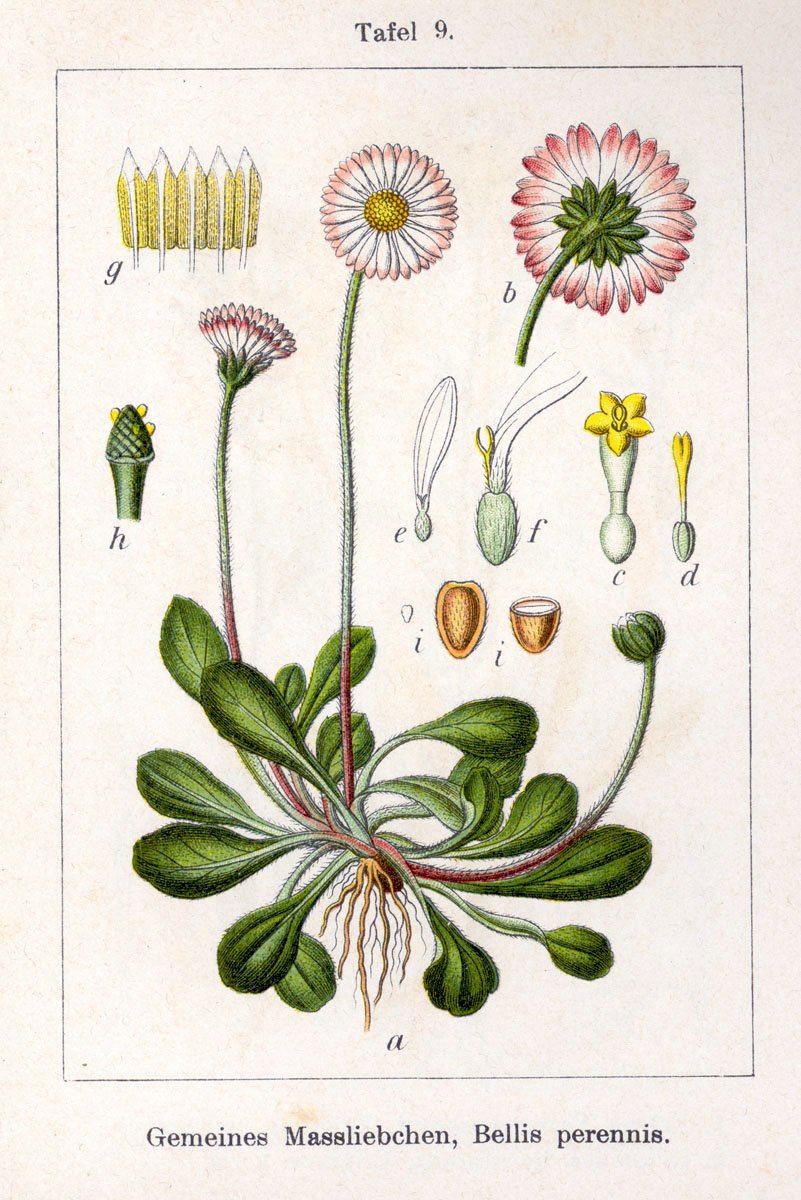 Daisy is a common perennial. The pinnate leaves range from oval to spatula-shaped. The rosette grows straight flower stalk with a single flower.
This flower stalk can be 20cm long. Occurs in almost all of Europe into Asia Minor. Also occurs in North America and New Zealand where it is introduced.
De young leaves are used as a substitute for spinach or lettuce. Contains vitamin C. The plant can be used to reduce inflammation.
Daisy is a common perennial. The pinnate leaves range from oval to spatula-shaped. The rosette grows straight flower stalk with a single flower.
This flower stalk can be 20cm long. Occurs in almost all of Europe into Asia Minor. Also occurs in North America and New Zealand where it is introduced.
De young leaves are used as a substitute for spinach or lettuce. Contains vitamin C. The plant can be used to reduce inflammation. |
| |
|
Other plants - Chamomile
|
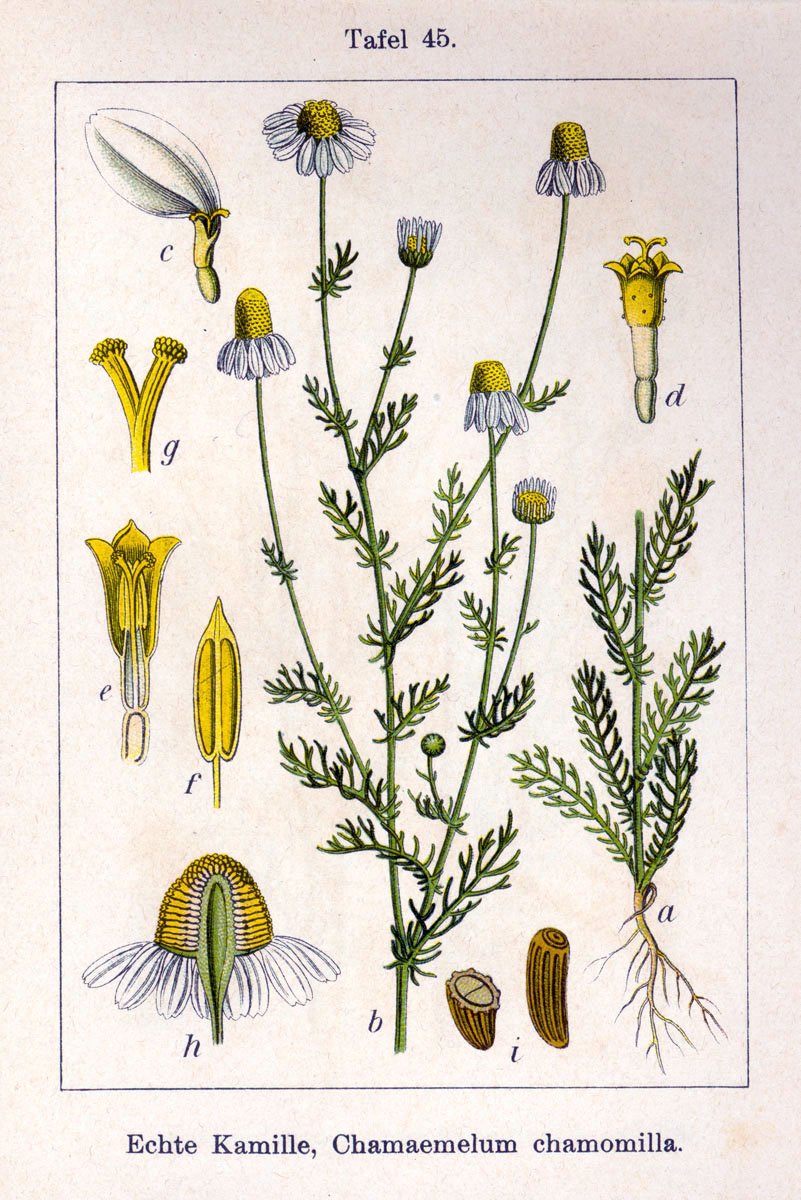 Chamomile is an annual plant that is 10 to 40cm high. The plant has hairy fern-like leaves that are on all sides, single flower heads are on top of a long
steal. The flower has a yellow disk flower outside with a white halo of ray flowers. At the end of flowering, white ray flowers bend down. Occurs almost
everywhere in Europe in dry, nutrient-rich soil. The flower heads can be picked when the petals droop. You can use fresh or dried flowers for a soothing
fragrant tea.
Chamomile is an annual plant that is 10 to 40cm high. The plant has hairy fern-like leaves that are on all sides, single flower heads are on top of a long
steal. The flower has a yellow disk flower outside with a white halo of ray flowers. At the end of flowering, white ray flowers bend down. Occurs almost
everywhere in Europe in dry, nutrient-rich soil. The flower heads can be picked when the petals droop. You can use fresh or dried flowers for a soothing
fragrant tea. |
| |
|
Other plants - Sorrel
|
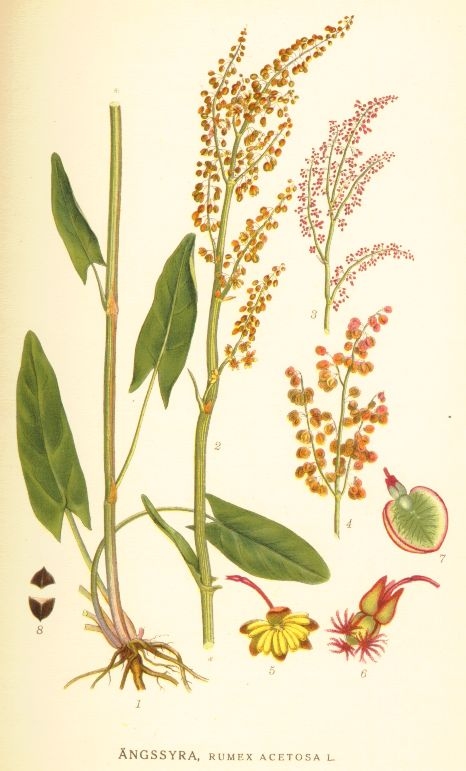 Sorrel is a perennial plant with a large bunch of hairless long stemed arrow-shaped leaves. This stems grow straight for 30 to 100cm. These include
flower stems. At the ends red-brown flower garlands. Found throughout Europe in forest clearings, along roadsides and on grasland. Jong leaves, buds and
young shoots at the top can be use as lettuce. The leaves can also be cooked like spinach.
Sorrel is a perennial plant with a large bunch of hairless long stemed arrow-shaped leaves. This stems grow straight for 30 to 100cm. These include
flower stems. At the ends red-brown flower garlands. Found throughout Europe in forest clearings, along roadsides and on grasland. Jong leaves, buds and
young shoots at the top can be use as lettuce. The leaves can also be cooked like spinach. |
| |
|
Other plants - Rosehip
|
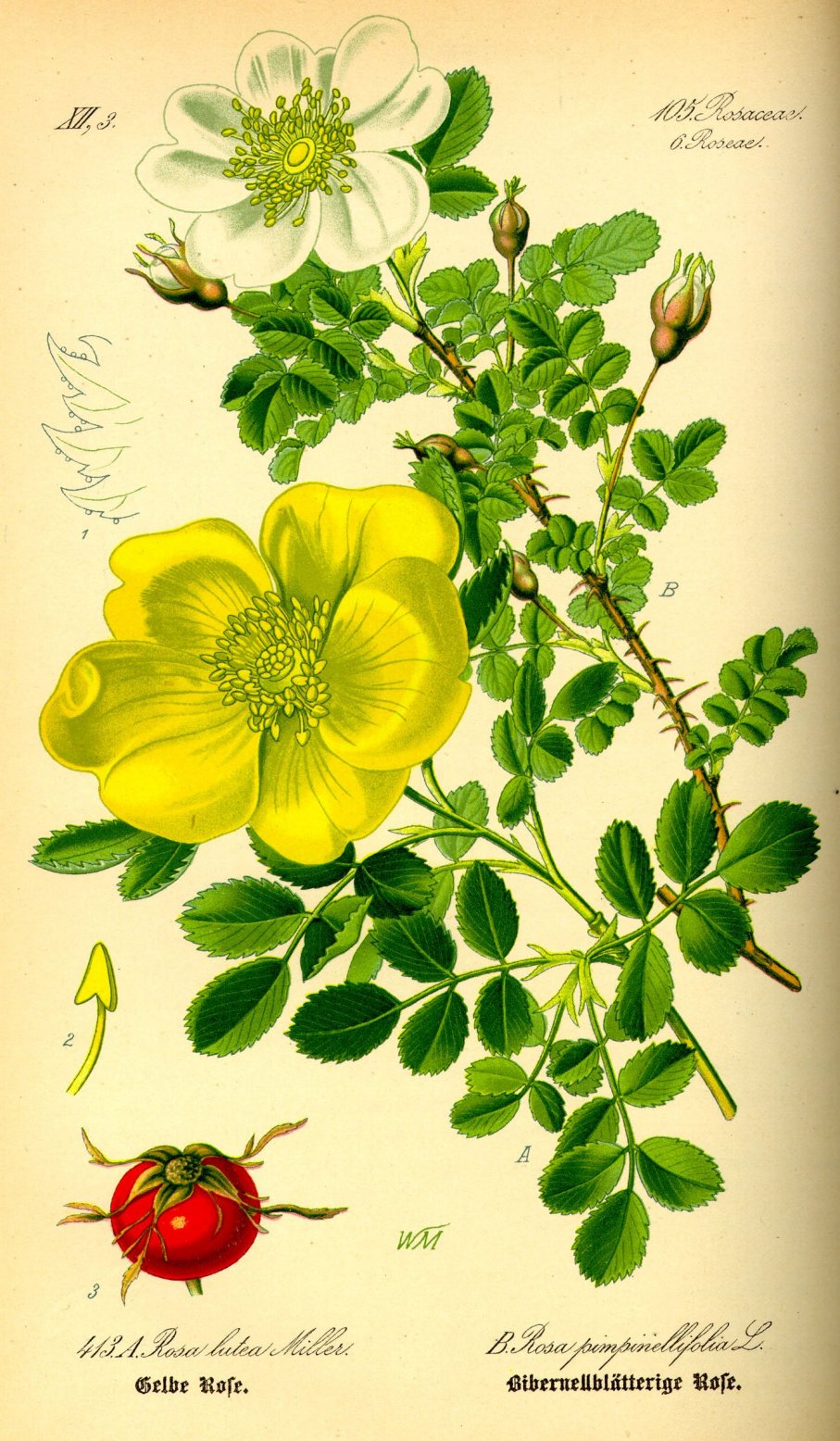 Rosehip is a fleshy fruit of a rose. These rose hips are the fruit of a dogrose which is a thorny rose plant with stems that curve up to 3 meters high. .
The flowers bloom in June and July and are pink or white. The fruits are orange and can be harvested from august to November.
Found along roads, in hedges and among bushes in Europe, Asia, South America and North Amerika and can be made into rosehip jam. They are rich in
vitamin C, they contain up to 20 times more vitamin C than oranges. Rose hips also contain vitamin A, B1 and B2.
Rosehip is a fleshy fruit of a rose. These rose hips are the fruit of a dogrose which is a thorny rose plant with stems that curve up to 3 meters high. .
The flowers bloom in June and July and are pink or white. The fruits are orange and can be harvested from august to November.
Found along roads, in hedges and among bushes in Europe, Asia, South America and North Amerika and can be made into rosehip jam. They are rich in
vitamin C, they contain up to 20 times more vitamin C than oranges. Rose hips also contain vitamin A, B1 and B2. |
| |
|
Other plants - Elder
|
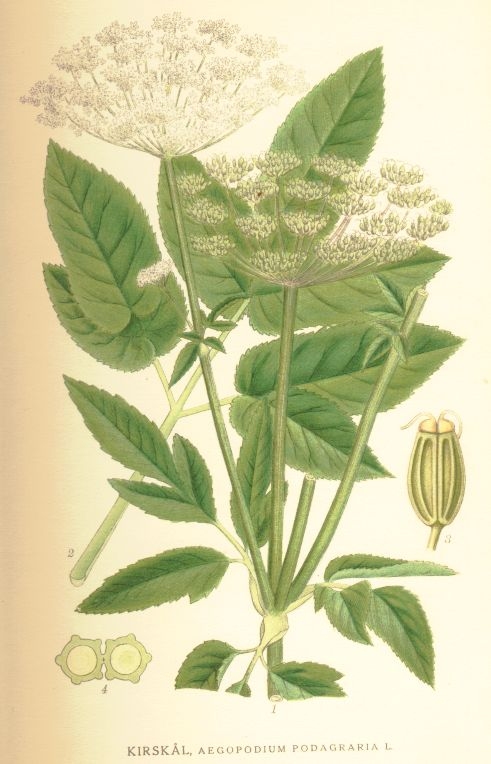 Elder is a perennial herb with creeping underground stems. Elder is 40 to 100 cm high, the steals are hollow and grooved. The flowering period is from
May to July. The flowers are white or pinkish and have heart-shaped petals. Elder is seen as a persistent weed. You can find him in almost entirely
herbaceous Europe, shady roadsides and fence walls. Pick the young leaves before flowering begins. Cook them in little water and then serve with some
butter. Elder contain minerals like, calcium, magnesium and iron. Young leaves contain much more carotene and vitamin C (70mg per 100g)
Elder is a perennial herb with creeping underground stems. Elder is 40 to 100 cm high, the steals are hollow and grooved. The flowering period is from
May to July. The flowers are white or pinkish and have heart-shaped petals. Elder is seen as a persistent weed. You can find him in almost entirely
herbaceous Europe, shady roadsides and fence walls. Pick the young leaves before flowering begins. Cook them in little water and then serve with some
butter. Elder contain minerals like, calcium, magnesium and iron. Young leaves contain much more carotene and vitamin C (70mg per 100g) |
| |
|
Other plants - Yarrow
|
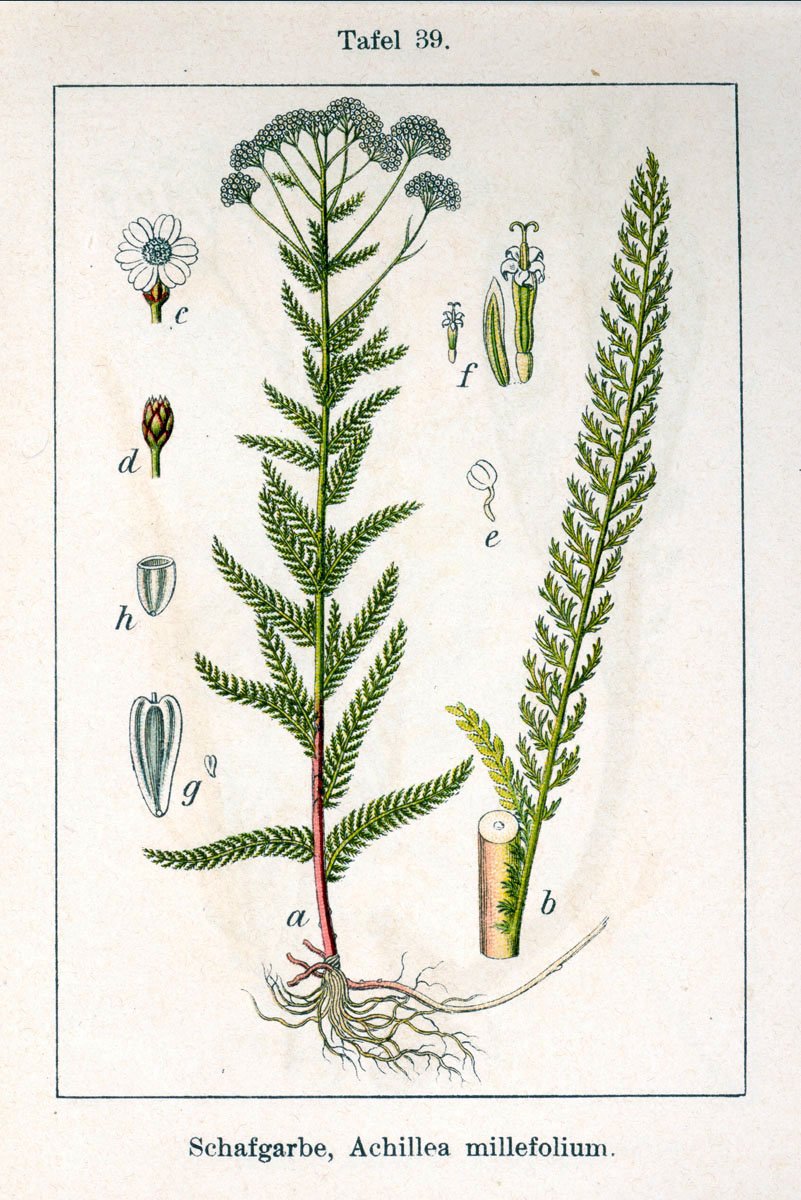 Yarrow is a sturdy perennial fern that grows in clusters together. They are 10 to 100 cm tall and smell strongly. The leaves are green and spring-like.
The flowers are creamy white or pink. Found throughout Europe in fields and dry pastures. It is also been seen in Asia, Australia and New Zealand.
They bloom from June to september. Pick the young leaves at the beginning of spring and chop finely, then add them to soups, sauces and omelettes.
Use the stem tips before the buds develop, after this use the flowers with a short stem. Use fresh or dried flowers to flavor food with.
They have a slightly salty, peppery flavor. Yarrow contains many minerals and essential oils. The plant has medicinal and stimulates digestion,
go against the cramps and inflammation. Add only small amounts on your food, and not too much otherwise it can cause skin irritation and dizziness.
Yarrow is a sturdy perennial fern that grows in clusters together. They are 10 to 100 cm tall and smell strongly. The leaves are green and spring-like.
The flowers are creamy white or pink. Found throughout Europe in fields and dry pastures. It is also been seen in Asia, Australia and New Zealand.
They bloom from June to september. Pick the young leaves at the beginning of spring and chop finely, then add them to soups, sauces and omelettes.
Use the stem tips before the buds develop, after this use the flowers with a short stem. Use fresh or dried flowers to flavor food with.
They have a slightly salty, peppery flavor. Yarrow contains many minerals and essential oils. The plant has medicinal and stimulates digestion,
go against the cramps and inflammation. Add only small amounts on your food, and not too much otherwise it can cause skin irritation and dizziness. |
| |
|
Other plants - Creeping thistle
|
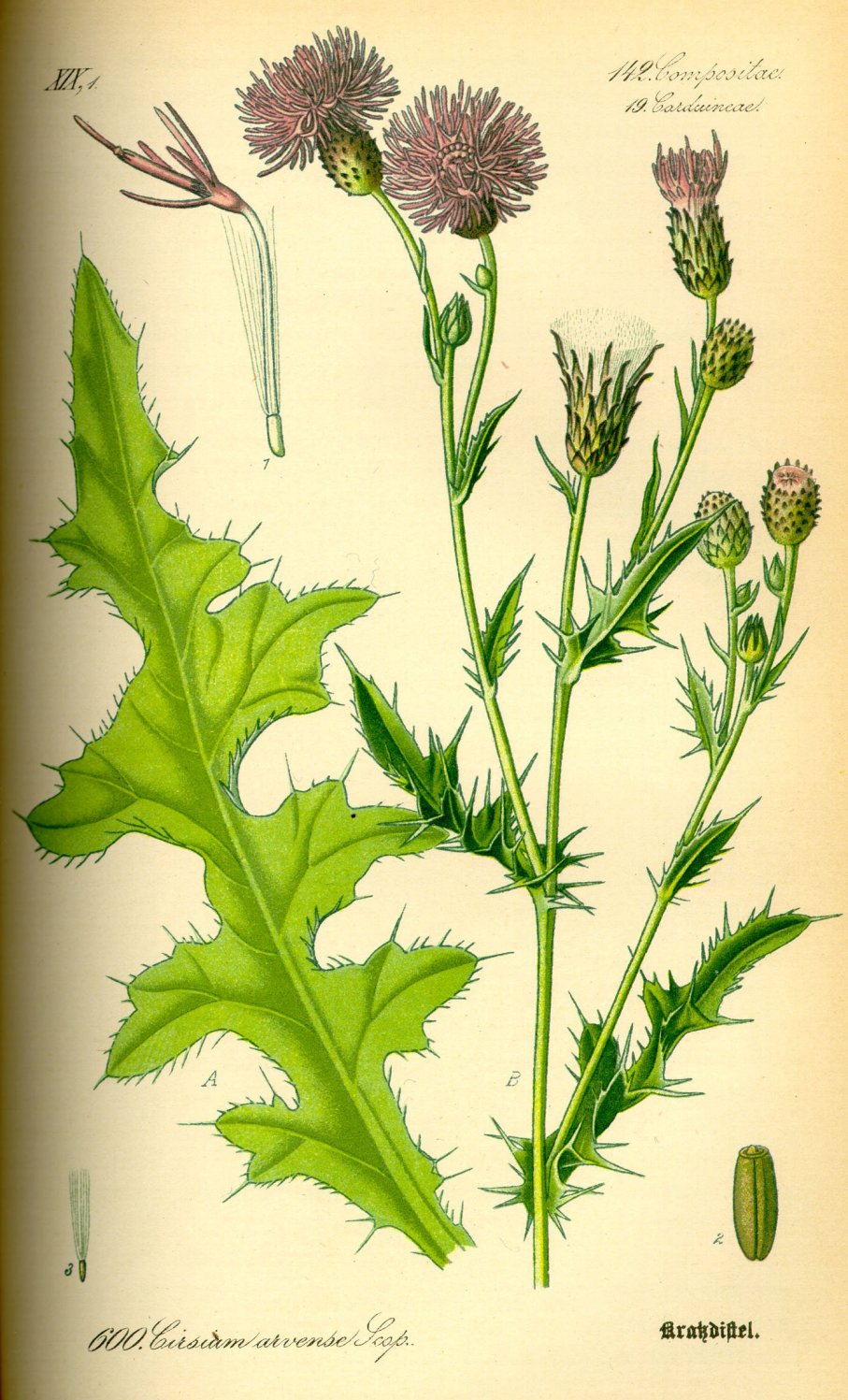 Creeping thistle is a common plant that growas up to 120 cm high. The stem is rarely branched. The dark green leaves are smooth and shiny, from top
to the bottom, leaves silvery white. Furthermore, the leaves lanceolate, prickly and are curly. In its heyday usually more there are more than four flower
heads which light purple to white flowers. The creeping thistle blooms from June to september. And it occurs on open, moist rich soil, on pastures,
roadsides and in vacant lot grond. Pickk the young shoots and remove the spines. Eat them raw in a salad or cook them as vegetables. The roots can
be peeled and eaten raw or baked.
Creeping thistle is a common plant that growas up to 120 cm high. The stem is rarely branched. The dark green leaves are smooth and shiny, from top
to the bottom, leaves silvery white. Furthermore, the leaves lanceolate, prickly and are curly. In its heyday usually more there are more than four flower
heads which light purple to white flowers. The creeping thistle blooms from June to september. And it occurs on open, moist rich soil, on pastures,
roadsides and in vacant lot grond. Pickk the young shoots and remove the spines. Eat them raw in a salad or cook them as vegetables. The roots can
be peeled and eaten raw or baked. |
| |
|
Other plants - Clover
|
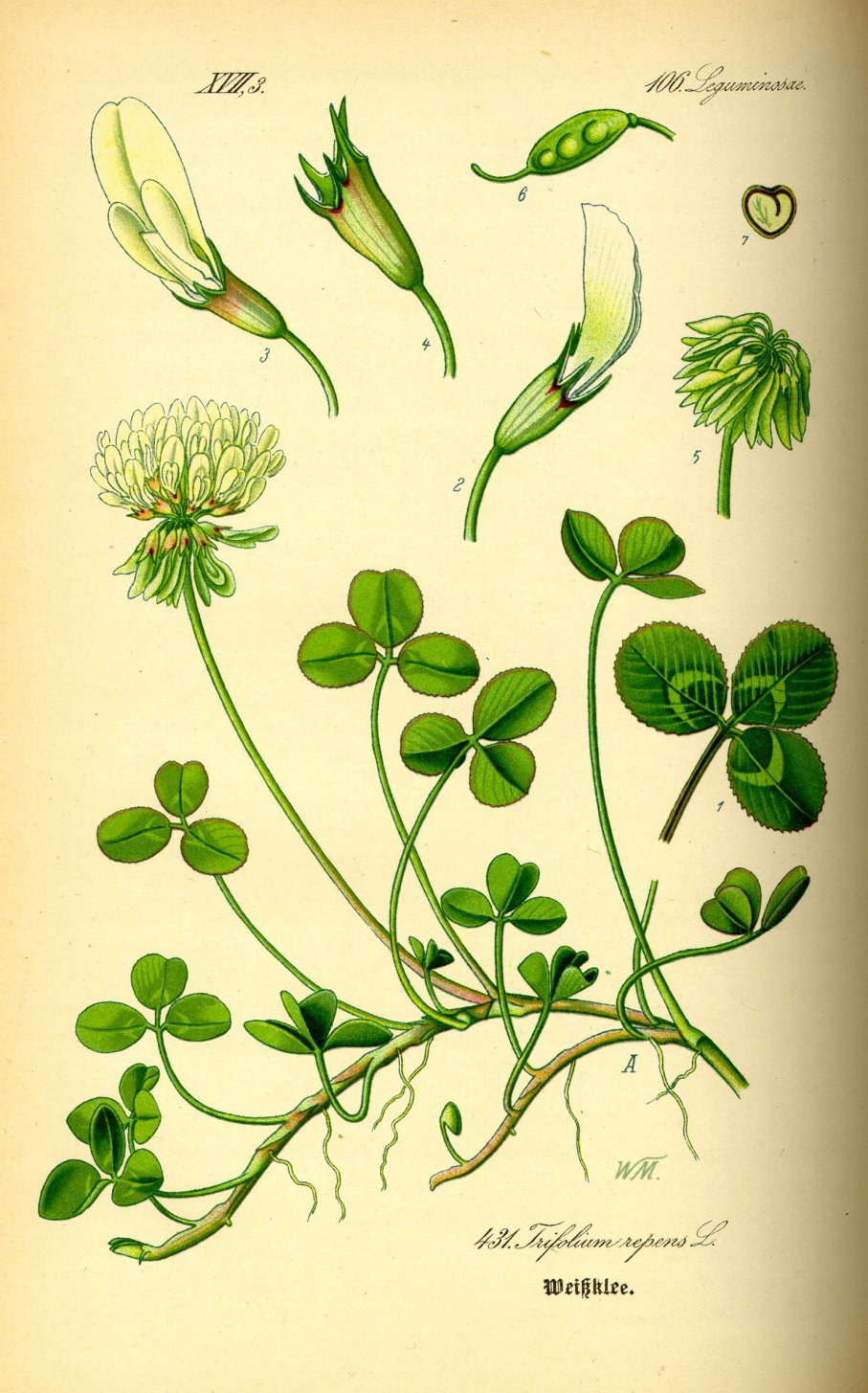 Clover is a perennial plant. Stems grow from a rhizome and out of each stem of three oval leaves grow. On the leaves
a pale crescent-shaped spot occurs. The flowers are united into heads and depending on the type of clover purple, white or yellow in color. Clover can
be found across Europe in grasslands, on paths and roads. The young leaves and flowers can be harvested from April to November. The leaves are
use raw in salads or cooked like spinach. The flowers are used as decorations in salads and are tasty. Dry the flowers to make tea.
Clover is a perennial plant. Stems grow from a rhizome and out of each stem of three oval leaves grow. On the leaves
a pale crescent-shaped spot occurs. The flowers are united into heads and depending on the type of clover purple, white or yellow in color. Clover can
be found across Europe in grasslands, on paths and roads. The young leaves and flowers can be harvested from April to November. The leaves are
use raw in salads or cooked like spinach. The flowers are used as decorations in salads and are tasty. Dry the flowers to make tea. |
| |
|
Other plants - Wild strawberries
|
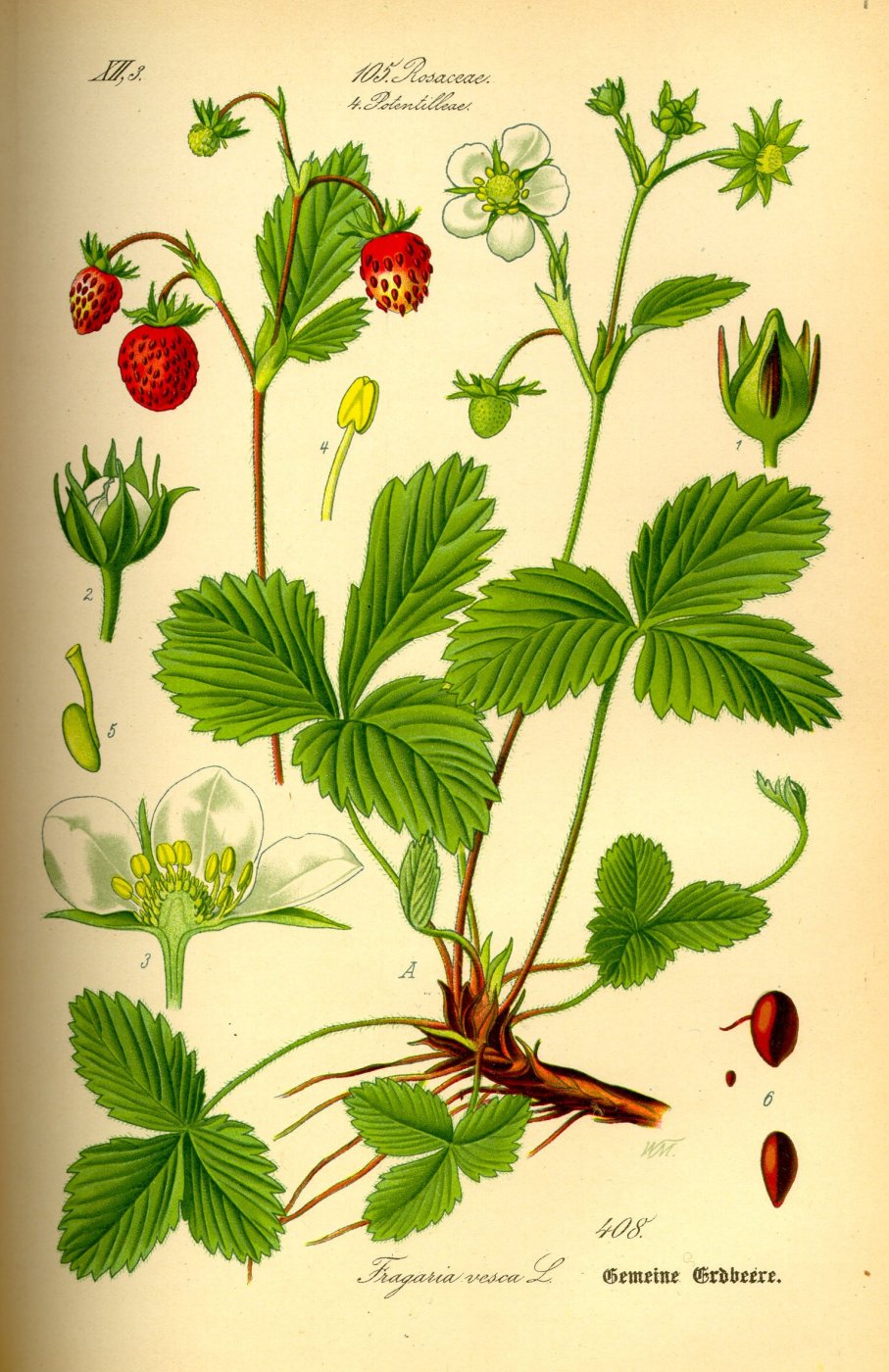 Wild Strawberry is a small perennial plant. The leaves consist of three serrated leaves that are shiny. The flowers are white with five petals.
The fruits are juicy strawberries and you'll find them from May until autumn. You wil find the Wild Strawberry in open woods, on forest edges and grassland
throughout Europa. The wild strawberry is easily confused with the appearance of strawberry that is not edible. The flowers are yellow in appearance
and the strawberry fruit is not juicy.
Wild Strawberry is a small perennial plant. The leaves consist of three serrated leaves that are shiny. The flowers are white with five petals.
The fruits are juicy strawberries and you'll find them from May until autumn. You wil find the Wild Strawberry in open woods, on forest edges and grassland
throughout Europa. The wild strawberry is easily confused with the appearance of strawberry that is not edible. The flowers are yellow in appearance
and the strawberry fruit is not juicy. |
| |
|
Other plants - Lantern Plant
|
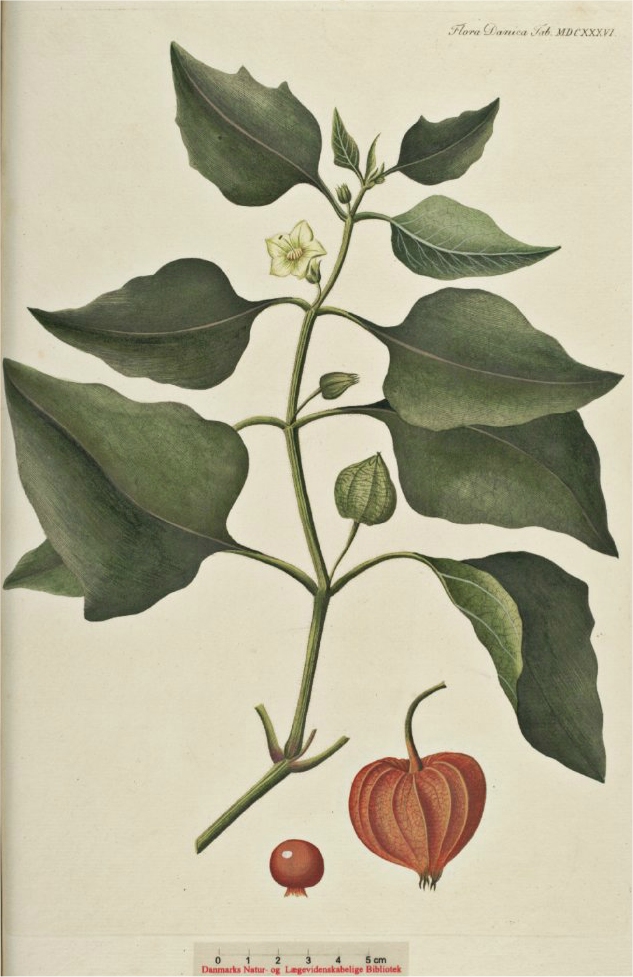 Lantern Plant, which is a perennial plant wich can reach 120cm. The stems are square and contain scattered stalked leaves. Alternately bloom 2-3 cm
large white star shaped flowers. During flowering, the sepals 5-8mm long. After flowering the calyx grows into the fruit it contains, this fruit
bowl together with a 4-5cm wide lampion. The flowering period is from June to september. The plant is probably from South Eastern Europe but is now found
in many parts Central Europe. The red fruit that is standing in the lantern can be eaten. The fruit contains sugar, citric acid, vitamin C, and physaline
iron. When picking the fruit, do not let the fruit contact with the lantern, This will give the fruit a bitter flavor.
The fruit of the Chinese lantern plant is located in the lantern and can be eaten.
Lantern Plant, which is a perennial plant wich can reach 120cm. The stems are square and contain scattered stalked leaves. Alternately bloom 2-3 cm
large white star shaped flowers. During flowering, the sepals 5-8mm long. After flowering the calyx grows into the fruit it contains, this fruit
bowl together with a 4-5cm wide lampion. The flowering period is from June to september. The plant is probably from South Eastern Europe but is now found
in many parts Central Europe. The red fruit that is standing in the lantern can be eaten. The fruit contains sugar, citric acid, vitamin C, and physaline
iron. When picking the fruit, do not let the fruit contact with the lantern, This will give the fruit a bitter flavor.
The fruit of the Chinese lantern plant is located in the lantern and can be eaten. |
| |
|
Other plants - Evening Primrose
|
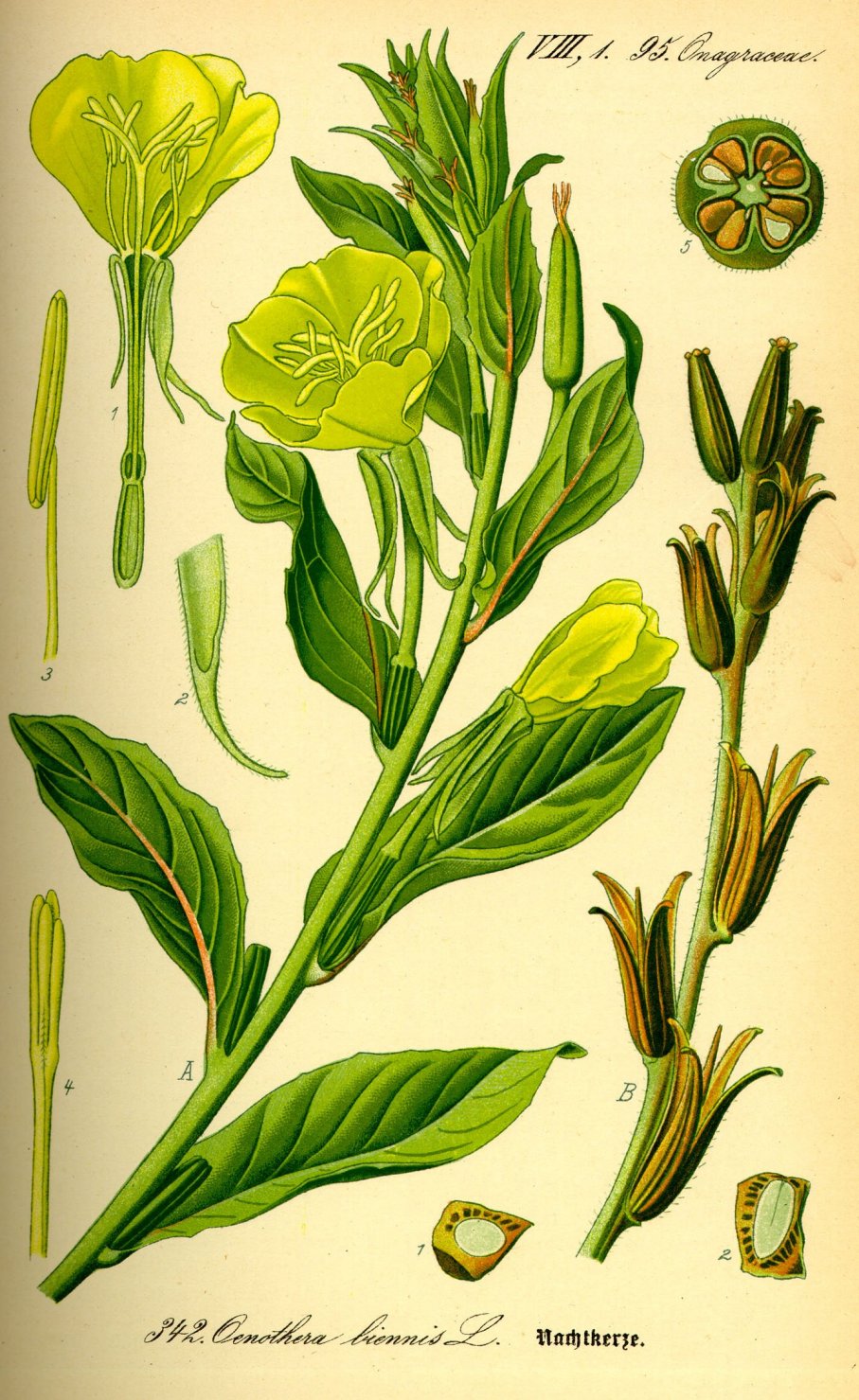 Evening primrose is a biennial plant with a taproot. In the first year forms a low rosette of rootleaves, the second year is a spike up to 1.50 m high
with yellow flowers. Evening primrose blooms from late June to mid August, the large yellow flowers have four petals, which grow obliquely upward.
Originally, the primrose comes from North America, but nowadays you can find him in large areas of wild land in Europe.
The taproot can be formed in the first year by peeling and then cooking. During the cooking, you will have toi change the water once.
The primrose roots and other species are also edible.
Evening primrose is a biennial plant with a taproot. In the first year forms a low rosette of rootleaves, the second year is a spike up to 1.50 m high
with yellow flowers. Evening primrose blooms from late June to mid August, the large yellow flowers have four petals, which grow obliquely upward.
Originally, the primrose comes from North America, but nowadays you can find him in large areas of wild land in Europe.
The taproot can be formed in the first year by peeling and then cooking. During the cooking, you will have toi change the water once.
The primrose roots and other species are also edible. |
| |
|
Other plants - Fireweed
|
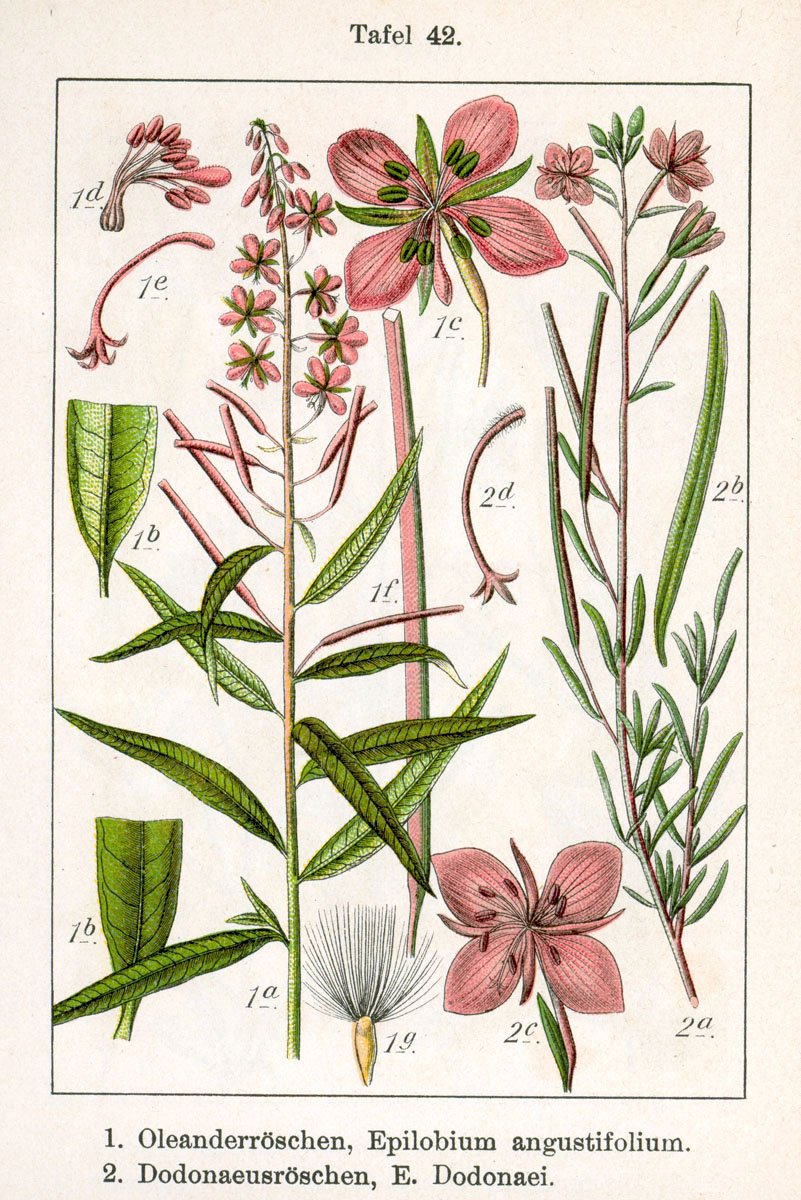 The fireweed is a perennial plant that takes its name from the fact that the leaves resemble that of the willow. The branched root system often
reddish leaves grow straight steal that can vary from 20 to 120 cm. 4 to 16 cm long stem leaves are dark green and grow up at an angle.
The fireweed blooms from June to August, then there are pink / purple flowers in wich stand large terminal spikes. The fireweed is to be found across
Europe in clearings in the forest, rocky places and on rubbish tips. Especially after a fire it has been spotted. Young fireweed leaves and young shoots
can be used as a vegetable or in soup. Use it as vegetables as asparagus shoots. Species wich look the same are not edible.
The fireweed is a perennial plant that takes its name from the fact that the leaves resemble that of the willow. The branched root system often
reddish leaves grow straight steal that can vary from 20 to 120 cm. 4 to 16 cm long stem leaves are dark green and grow up at an angle.
The fireweed blooms from June to August, then there are pink / purple flowers in wich stand large terminal spikes. The fireweed is to be found across
Europe in clearings in the forest, rocky places and on rubbish tips. Especially after a fire it has been spotted. Young fireweed leaves and young shoots
can be used as a vegetable or in soup. Use it as vegetables as asparagus shoots. Species wich look the same are not edible. |
|
|
|
|